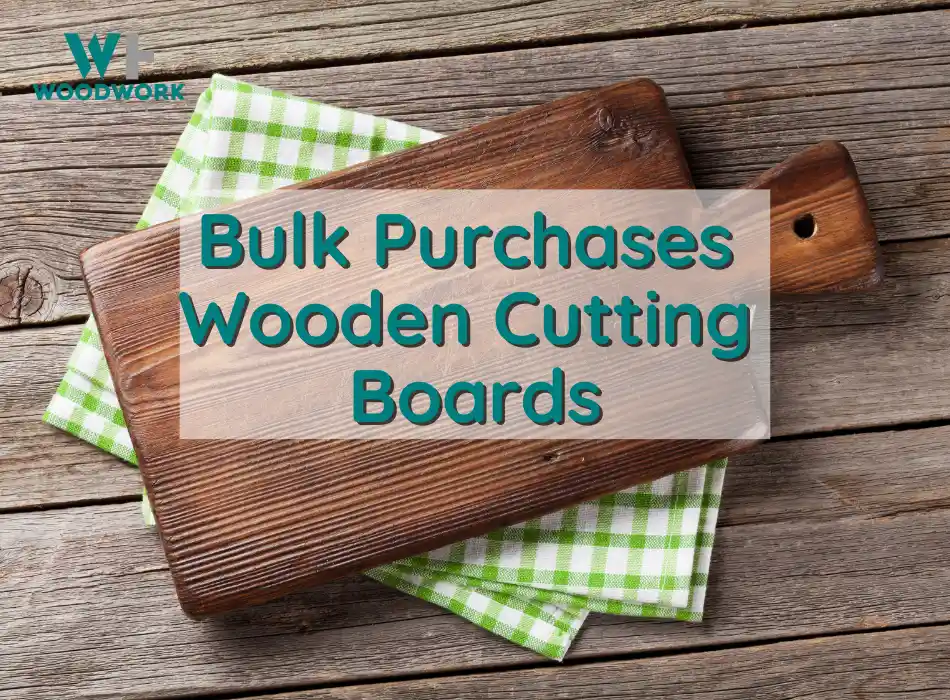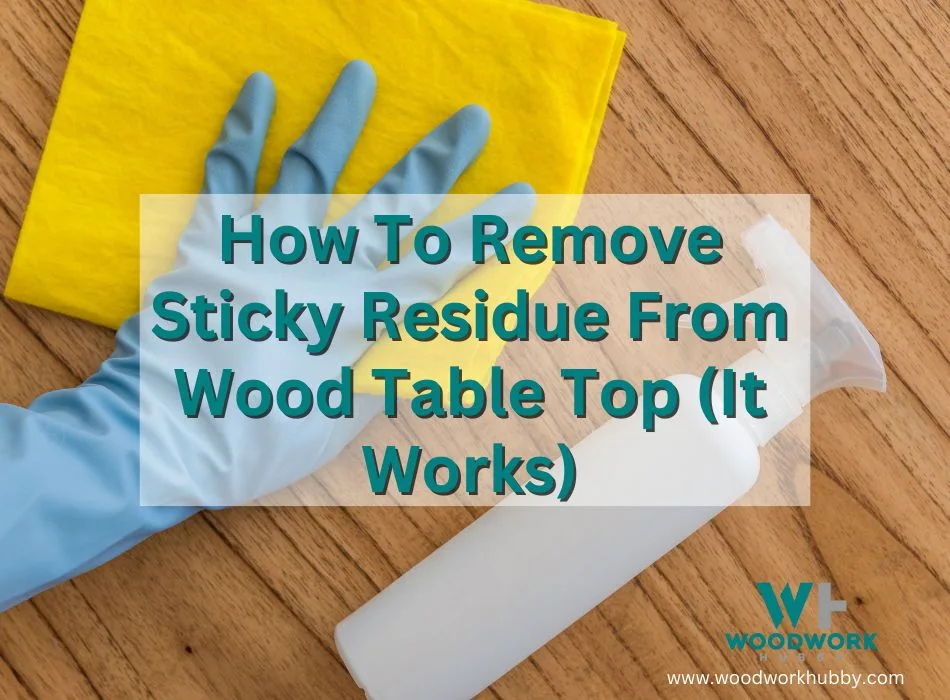Linseed treatment is easy on the eyes and the wallet. But what do you do when you’ve already treated a block of wood with linseed oil and still have more to do? Don’t worry; I have found from personal experience that the traditional wisdom regarding oil and adhesives doesn’t apply to linseed-oil-treated wood.
On average, glue can stick to linseed oil provided the oil is left 48 hours before the glue is applied. To stick glue to a linseed oil-treated surface, you should wait for the oil to oxidize. Then, the adhesion is to the surface and not the unstable oil layer.
In this article, I will show you a test I did to see if wood glue will stick to linseed oil, I will also go over the options you have when trying to glue a surface previously coated with linseed oil. You will also learn why linseed oil is different from most other oil finishes and the specific adhesiveness of different types of glue to oiled wood.
Finally, I will discuss some finishing options and a few adhesives that are guaranteed to stick to oil-finished wood regardless of how thick the finish is.
Can You Glue Wood After Linseed Oil?
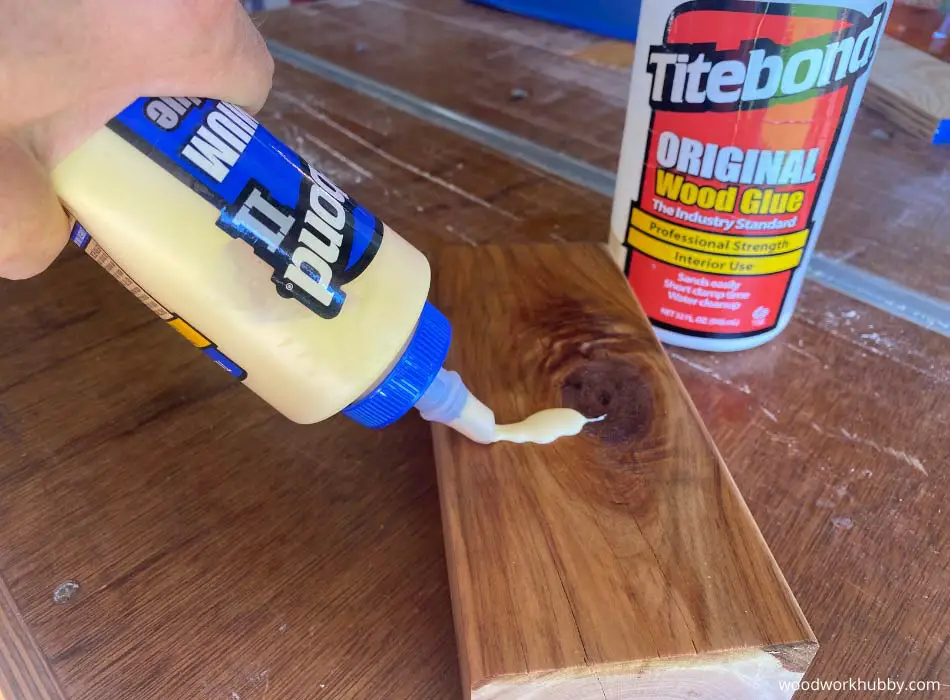
You can glue wood after linseed oil because once it is oxidized, it finishes dry, which leaves room for other finishes, including an adhesive one. However, because there is room for error, one should err on the side of caution and either sand wood before gluing or use acetone to clear the oil coat.
The problem with making use of sanding to offset linseed oil adhesion issues is that the oil penetrates deep into the wood. So even when you make a deep inlay, you still glue the wood where is linseed oil has reached. Carpenters and woodworkers have been favoring inlays and deeper pegging for oil-treated surfaces to avoid gluing appendages to a surface layer.
An oil finish that isn’t completely dry destabilizes the structure glued to the surface it covers. But dry finishes don’t have as significant a layer, anyway. While many people swear by making deep inlays before gluing anything to a wood surface priorly treated with linseed oil, they’re simply praising wood glue’s adhesion to linseed oil-treated areas.
Be sure to check out my results on using danish oil over sanding sealer.
The inlay can add more stability to the connection because of the depth at which one piece is anchored into the wood. But it doesn’t make the glue any more adhesive simply because oxidized linseed oil doesn’t interfere with the glue’s adhesion to the surface it covers.
I tested different types of glue on a series of hardwoods and softwoods treated with linseed oil. To my surprise, the lumber itself didn’t affect the results as much, which is why the table below doesn’t register wood type as a variable.
Grab yourself some Titebond wood glue from Amazon.
Franklin International 5064 Titebond Original Wood Glue
The type of glue played a role, but after a long-enough period since the oil application, almost every glue had firm adhesion. Here are the results of my tests.
| Glue Type | On Wood after 24hrs of linseed oil Treatment | On Wood after 36hrs of linseed oil Treatment | On Wood after 96hrs of linseed oil Treatment |
|---|---|---|---|
| PVA (Polyvinyl Acetate) – a.k.a. Wood glue. | Weak adhesion | Acceptable adhesion, though joints could be taken apart. | Strong adhesion. |
| Polyurethane Glue | Mild adhesion | Strong adhesion, no short-term weakness noticeable. | Excellent adhesion. |
| Epoxy Glue | Strong adhesion. Even wet oil did not seem to affect the glue strength. | Strong adhesion, with more stability. | Indistinguishable from the 36-hour application, but presumably with longer-lasting stability. |
| Super Glue | Strong adhesion. The effort required to separate joints. | Strong adhesion. Considerably more stable. | As strong as can be. |
| Hide Glue | Descend adhesion. Better than PVA. | Strong adhesion, nearly impossible to pull apart. | Excellent adhesion. One of the softwood planks broke when trying to pry it apart. |
Test Results Of Wood Glue To Linseed Oil
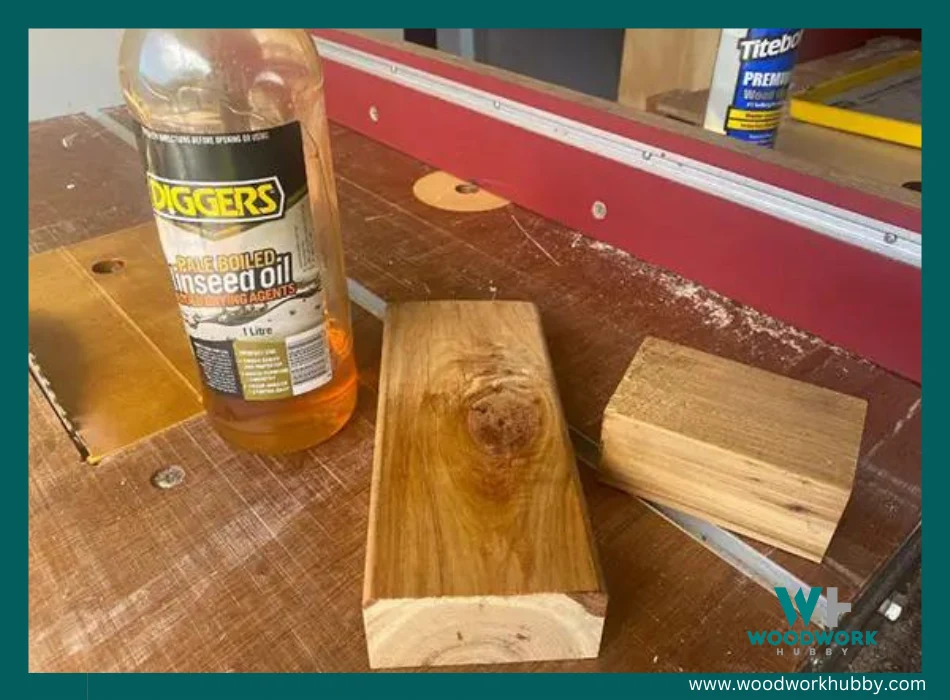
I applied 3 coats of linseed oil to this scrap of timber.
2. List item 2

Lorem ipsum dolor sit amet, consectetur adipiscing elit. Vivamus convallis nec purus vel bibendum. Sed eget ex vel urna ullamcorper lacinia ac sit amet nunc. Maecenas in tortor sed arcu bibendum fringilla ac nec odio. Praesent quis mauris dolor. Proin posuere velit quis orci pellentesque, eu semper lectus ultrices. Nam sit amet viverra nulla, bibendum porttitor enim. Vivamus dignissim congue est, sit amet volutpat leo pellentesque non.
3. List item 3

Lorem ipsum dolor sit amet, consectetur adipiscing elit. Vivamus convallis nec purus vel bibendum. Sed eget ex vel urna ullamcorper lacinia ac sit amet nunc. Maecenas in tortor sed arcu bibendum fringilla ac nec odio. Praesent quis mauris dolor. Proin posuere velit quis orci pellentesque, eu semper lectus ultrices. Nam sit amet viverra nulla, bibendum porttitor enim. Vivamus dignissim congue est, sit amet volutpat leo pellentesque non.
4. List item 4

Lorem ipsum dolor sit amet, consectetur adipiscing elit. Vivamus convallis nec purus vel bibendum. Sed eget ex vel urna ullamcorper lacinia ac sit amet nunc. Maecenas in tortor sed arcu bibendum fringilla ac nec odio. Praesent quis mauris dolor. Proin posuere velit quis orci pellentesque, eu semper lectus ultrices. Nam sit amet viverra nulla, bibendum porttitor enim. Vivamus dignissim congue est, sit amet volutpat leo pellentesque non.
5. List item 5

Lorem ipsum dolor sit amet, consectetur adipiscing elit. Vivamus convallis nec purus vel bibendum. Sed eget ex vel urna ullamcorper lacinia ac sit amet nunc. Maecenas in tortor sed arcu bibendum fringilla ac nec odio. Praesent quis mauris dolor. Proin posuere velit quis orci pellentesque, eu semper lectus ultrices. Nam sit amet viverra nulla, bibendum porttitor enim. Vivamus dignissim congue est, sit amet volutpat leo pellentesque non.
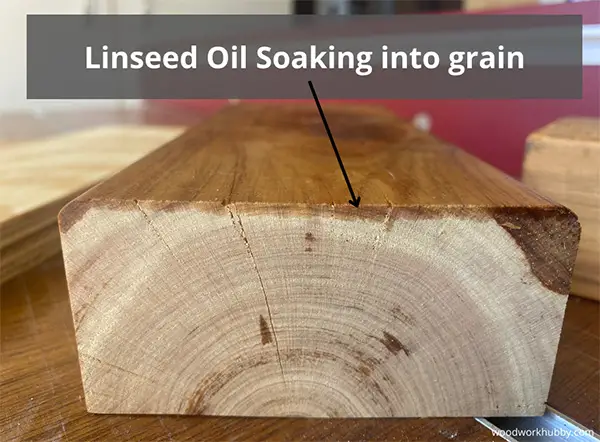
You can see the oil soaked into the grain well.
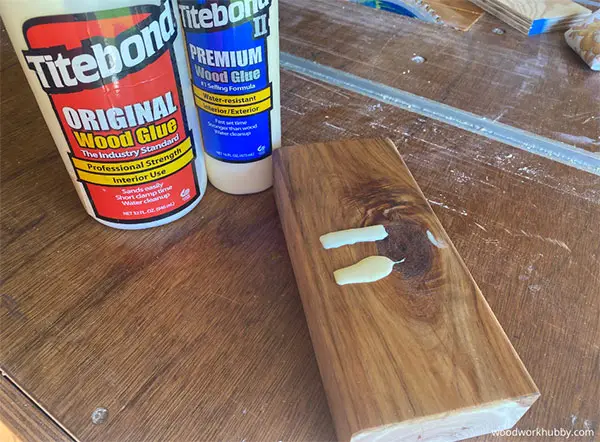
After 1 hour, I applied 2 strips of glue, Titebond 1 & 2 wood glue.
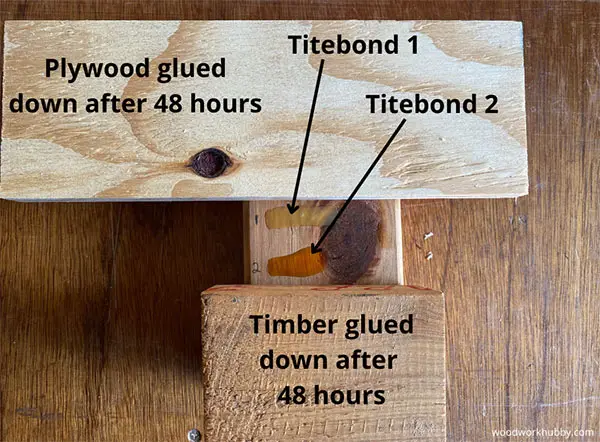
A piece of timber & plywood was glued down after 48 hrs.
The Results Of My Test
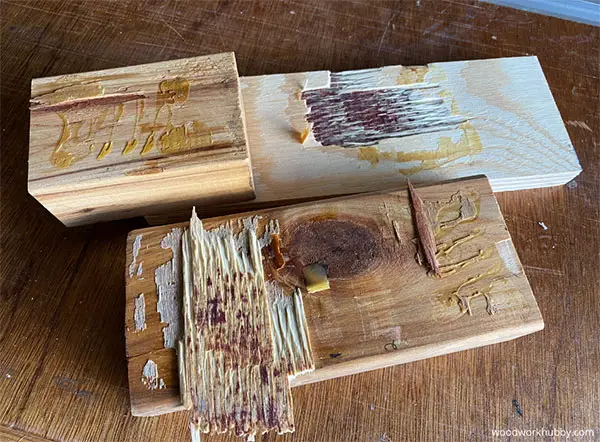
The wood glue does hold!
Even though the glue held as you can see from the broken timber fibers, I would always wait up to 72 hours before applying glue to a joint. For peace of mind, I would make sure those joints were not carrying too much weight either.Even though the glue held as you can see from the broken timber fibers, I would always wait up to 72 hours before applying glue to a joint. For peace of mind, I would make sure those joints were not carrying too much weight either.
The guy in the video below did a test that shows the glue not sticking well. I found the same result but when I clamped the 2 pieces of wood on top and left them to dry, The glue actually tore the wood fibers suggesting there was a bond.
Can You Glue Oiled Wood?
In general, you can glue oiled wood after 72 hours of dry time. The degree to which that’s going to be a problem depends on how thick a layer of oil coats the wood.
This is not recommended though as most wood glues are water-based and putting them over oil does not make for a perfect bond. It did work in my tests, but please use caution and test with the wood you are using first.
There are a few things you can do to glue oiled wood. Again, there are no hard and fast rules regarding coated wood joinery and how much caution you want to exercise depends entirely on the kind of results you’re looking for.
The table below covers your options based on the situation.
| The Context | What You Should Do | Comments About The Result |
|---|---|---|
| The wood has a thick, shiny layer on top. | You can sand the surface if you want to apply the glue. | The strength of the glue will depend on how well the layer has been removed. This doesn’t work if the oil penetrates deep below the surface. |
| The wood has a shine from the oil finish but feels natural | You can use wood glue for medium-to-small strength projects. For projects that demand higher strength, you should opt for non-water-based glue. | The adhesion depends on the grain of the wood, the quality of the glue, and the size of the surface and the appendage. |
| The wood was treated with a dry finish oil a few weeks ago. | You can use any wood glue for a medium-strength project and can opt for non-water-based glue for projects that require firm adhesion. | In most cases, the adhesive will perform as if there were no finish. |
This is a good linseed oil to use that I have gotten good results with.
Linseed Oil and Adhesives: Waiting Time and Best Practices
Attaching an appendage, block, or sheet to a piece of wood treated with linseed oil is not too difficult. I have found no short-to-medium-term issues gluing wood after coating it with linseed oil. In some instances, the color of the wood changes, and on one particular try, the wood didn’t accept the glue.
Here are a few things I learned from over twenty-five experiments with linseed oil and wood.
- Sanding has little to no impact – Speaking strictly about fully cured linseed oil, glue doesn’t act any differently when applied to the finished surface than to a sanded one.
- The linseed oil can interfere, but in rare circumstances – When you apply glue right after applying linseed oil, a film of the oil can keep the glue from anchoring into the surface underneath. The longer you wait, the better the glue sticks.
- The perfect waiting period is 96 hours – Even though linseed oil dries around 72 hours after applying, I have found the firmest adhesion on pieces that were left to cure for 96 hours.
Many of us keep old bottles of linseed oil sitting around. Let’s face it, it’s a great finish. A lot of people do ask me, does linseed oil go bad? See my response here.
Does Super Glue Work on Oiled Wood?
Superglue works on oiled wood because it is an acrylic-resin-based adhesive that is unlike water-based glues. Still, it is advisable to sand a surface and minimize the oil layer on the wood surface before applying any adhesive, super glue, or otherwise.
Recently, some non-cyanoacrylate varieties of Super Glue have come to the market. Though the chances of you getting one of those on the accident are pretty low, it is still advisable to ask specifically for Cyanoacrylate glue. If you have a “regular” super glue already, you can use it on oiled wood without worrying about adhesion.
Danish oil is a great finish but does it work on Oak veneer? Check out my article to find out more.
And if the oil in question is a dry finish type, then you have even less to worry about. That said, you should be practical about the scope of the adhesive.
While super glue can work on oiled wood, it cannot be used to hang a mahogany frame from a plywood ceiling.
The best one can say about dry finish oils, and super glue is that they won’t interfere with each other. The limitations of the specific adhesive still apply.
What Finish Can Be Applied Over Linseed Oil?
You can apply any oil-based finish over linseed oil once it has sufficiently cured. There have been no reports of problems with any kind of finish on wood treated with linseed oil, except with fresh attempts. Do not apply any finish over linseed oil within the first 24 hours.
It takes 72 hours for linseed oil to cure to a working extent. For finishing purposes, you should add another 24 hours of waiting time. After 96 hours of applying linseed oil, you can use any finish over the surface.
Since no finish gets resistance from fully oxidized linseed oil, the question isn’t about which finish you can apply but which one you should use. Here are your options.
| The Finish | The Key Benefit |
|---|---|
| Varnish | Add a significant shine to the project and make it appear brighter despite the matte-ness of the surface prior to the treatment. |
| Polyurethane | Waterproofs the wood to a functional extent. |
| Shellac | Smoothens the wood while retaining natural grain. |
| Lacquer | It makes the wood damage-resistant to an extent, water-resistant to a greater extent, and retains the surface’s own color. |
| Wax | Provides stain resistance for a limited period. |
Final Thoughts – Does Glue Stick To Linseed Oil?
I have found the glue to work perfectly well on linseed oil. I did try using adhesive in the first 96 hours of applying linseed oil, but when the oil was cured beyond a doubt, all experimental applications of water-based adhesives and oil-based glues turned out to be valid.
Still, to minimize risks, I would recommend turning away from water-based glues and using something like super glue to fix two blocks of finished wood.


